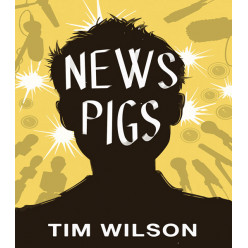The Angel's Cut
Immediate Download
Download this title immediately after purchase, and start reading straight away!
View Our Latest Ebooks
Explore our latest ebooks, catering to a wide range of reading tastes.
A sequel to her award-winning bestseller The Vintner's Luck, The Angel's Cut is an evocative and wildly romantic new novel from Elizabeth Knox.
Boomtown Los Angeles, 1929: Into a world of movies lots and speakeasies comes Xas, stunt flier and wingless angel, still nursing his broken heart, and determined only to go on living in the air.
But there are forces that will keep him on the ground. Forces like Conrad Cole, movie director and aircraft designer, a glory-seeking king of the grand splash who is also a man sinking into his own sovereign darkness.
And Flora McLeod, film editor and maimed former actress, who sees something in Xas that no-one has ever seen before, not even God, who made him, or Lucifer, the general he once followed -- Lucifer, who has lost Xas once, but won't let that be the end of it.
Praise for The Angel's Cut
As with her previous angel book, The Angel's Cut contemplates the big questions. But this time, Knox immerses us in a more familiar historical milieu, the nascent Hollywood film industry. The book contains characters we instantly recognise from 1930s movies, from wisecracking gals who can hold their liquor and their fellas, to careless, fast-talking, wild-drivingyoung men: all of them deeply flawed, fascinating and living life as if it might end at any moment. The immortal angel Xas should be repulsed or at least exasperated by this excess. But it's the passion, exuberance and irrational joy of being human that Xas (and Knox) plump for every time.
Jose Borghino THE AUSTRALIAN
Knox's 1998 bestseller is a category-obliterating tour de force: a literate fantasy, a theological love story, a New Zealand novel set in 19th-century France. It's a delight on every level and it needs a sequel the way the Moonlight Sonata needs a heavy metal version. So why saddle it with one? The only good answer to this question is a sequel so good it sits on the original not like a saddle, but like a halo; and that is the answer Knox provides.
...This is a novel Knox has been moving towards writing her whole career. I'm glad she didn't get to it earlier, because good as her writing has always been, it's got better. No New Zealand writer has a stronger lyric gift than Knox; she can make language sing, and at the same time she studs her prose with complex metaphors that expand and enrich the world they describe.
David Larsen THE LISTENER
The Angel's Cut offers aching loss with deftness and wistfulness. It is the kind of novel that elicits a sigh at its dénouement. This must surely be one of the books of the year.
Gilbert Wong METRO
Elizabeth Knox is the author of eight previous novels for adults and two for children as well as a collection of nonfiction published to acclaim in 2008, called The Love School: Personal Essays. She is one of New Zealand's most successful writers and has a keen readership both in New Zealand and overseas.
The book that Elizabeth is perhaps best known for is The Vintner’s Luck, first published 1998, which was a huge bestseller in New Zealand. It has sold over 45 000 copies in New Zealand and over 100,00 copies worldwide. It won the Deutz Medal for Fiction at the 1999 The Montana NZ Book Awards, where it also received the Readers' Choice and Booksellers' Choice awards. It was longlisted for the 1999 Orange Prize for fiction (UK) The Vintner’s Luck won the 2001 Tasmania Pacific Region Prize, and has been made into a film by Niki Caro.
From: The Angel's Cut, by Elizabeth Knox
The English Channel
1917
The Zeppelin hung concealed in cloud, a layer of thick stratus with a base three thousand feet above the sea. The airship’s navigator—the angel Xas—was in the control cabin, studying a map in the greenish light from the gauges, when his captain came to stand beside him. They looked out together on the ghostly country of cloud.
‘Hans,’ said Captain Hintersee, ‘would you say that this cloud extends all the way to Dover?’
The navigator Hans Ritt was famous in the fleet, for he never lost his way. Pilots navigated using compasses, and by making dead-reckonings from roadmaps they carried. They dropped down and looked for landmarks. But Ritt seemed to know all of Europe from the air; to have it in his head. Even without a compass and in the thickest fog he always knew where north lay.
That night, over the Channel, Xas turned his eyes from the window and the gauzy white topography below to tell his captain that yes, he did think the cloud cover extended from coast to coast. Then he dropped his chin and waited. The Zeppelin captain frowned at him. ‘Perhaps you should—’ he began, then caught himself and modified his suggestion so that it was an order. ‘Hans, I want you to take the cloud car down and take a look about.’
Xas stood straight, clicked his heels, then smiled happily, which spoiled the effect of military propriety. ‘Thank you, captain,’ he said, and left Hintersee’s side.
He reported to the belly of the airship, where he found the cloud car ready, its attendants around it, and at the controls of the winch and its thick coiled cable.
The car was a basket made of hardwood struts covered in canvas, a streamlined cradle with a bulbous front end where an observer would sit, hunched behind a low windscreen. It was equipped with a telephone the observer used to communicate with the control cabin.
The basket was positioned above a gap in the longitudinal girders of the airship’s frame. It hovered, swinging slightly. Cloud fumed through the gap.
Xas wriggled and jumped and tugged his way into a thick, fleece-lined canvas suit. He put on a helmet and gloves. Two crew members held the basket steady as he clambered through the cables that kept it level. He positioned his goggles, hunkered down, and gave the crew the thumbs up. The winch spun, the cable unwound, and the cloud car took him out of the light inside the airship, and into the wet white air.
Cloud came between him and the airship. The diffuse patch of brightness that was the gap in its belly dimmed, then disappeared. The hum of its engines grew muffled.
Xas removed his goggles, helmet and gloves and stuffed them between his knees. He was always careful to put the protective gear on again before he returned to the ship. The gear was, like his name, a disguise he wore for the benefit of others.
He raised his hands and opened his mouth and let the air caress him. As the basket cut its way through the lower layer of cloud, its cables acquired thin white streamers of vapour. Xas ran his fingers back and forth through these dragons’ whiskers, which broke and eddied like smoke rings.
The cloud car passed through the thinning vapour, and Xas looked down.
The sea was dark, but textured, its waves backlit by the faint radiance of a rainfall several miles away. Xas could see where the rain softened the air. He could see too that there were several interruptions in the sea’s surface. Black strokes. Three ships, showing no light. He waited till his eyes made a further adjustment and he could spot each ship’s wake, and therefore the direction they were headed.
He picked up the telephone, and put it to his ear. There was a loud click, then the electric hum of the open line. He asked Hintersee to have the men in the belly of the airship lower him a further ten feet. He said that the cloud was thicker than they’d thought. He reported that he was only just out of it. Really he hoped to relish more of the clear sky under the cloud.
The basket shivered as the winch started up again far overhead. The soft bright underside of the cloud receded, and the wind grew a little less wet. He savoured it. In a moment he would turn to his duty, but for now he swung through the dark in his own true home, the fully three-dimensional terrain of the sky.
He took a moment, then put the phone back to his ear and began to talk to his captain, to relay the bearings of the target ships.
Suddenly, a coil of vapour spun down past the cloud car. Dark spirals of turbulence appeared in the underside of the cloud some twenty feet above. Xas knew at once what was causing it. Clear air from above the layer of cloud was being forced down through it, making black vortices in the vapour, vortices formed by the tips of great wings describing high-velocity parabolas, and mixing fog and air.
Xas dropped the phone. The soft ceiling above him ruptured. A huge dark shape pierced the cloud and opened a gap through to starlight. Wings made a rushing thump in the air. Xas felt the concussions of displaced air shuddering around him.
The archangel braked his plunge, then banked against unbroken cloud, coming around in a tight loop that would bring him back to where Xas hung in the fragile cradle of the cloud car. Xas saw that the attenuated avian hands on the wrist joints of the archangel’s six wings were splayed, reaching. He saw light flash on the pale palms of the archangel’s two human hands. And, as the huge winged body closed on him, he saw that one of those many, avid hands was missing some fingers. It was by this mutilated hand that Xas recognised Lucifer—who had cut off his wings.
He threw himself out of the cloud car.
Looking back through his feet as he fell, Xas saw the archangel connect with the cloud car, catch hold of it, and hang swinging, hands gripping the basket, two top wings flared back and flapping furiously. He heard the cable shriek and groan. And he heard his name, for the first time in over fifty years. Lucifer shouted, ‘Xas!’ and Xas closed his body into a ball. He knew he could fall faster than Lucifer could fly down. The archangel had too much surface area to race any falling, wingless creature a few thousand feet to the sea.
Xas plunged straight down, and hit the surface of the sea so hard that he rebounded once before sinking into it. He let out all the air in his lungs and stopped breathing.
It was cold and dark under the water. Far away the ships’ propellers whined like bees caught behind a curtain. Xas hung below the surface and looked up through murky transparency at that surface in reverse—the gleam of light on the backs of the waves. After a moment he saw the ragged star of Lucifer’s form pass above him. The sea turned momentarily smooth in the downblast of the archangel’s wings. Then Lucifer banked and drove upward, disappearing in a flicker of darkness into the night sky.










